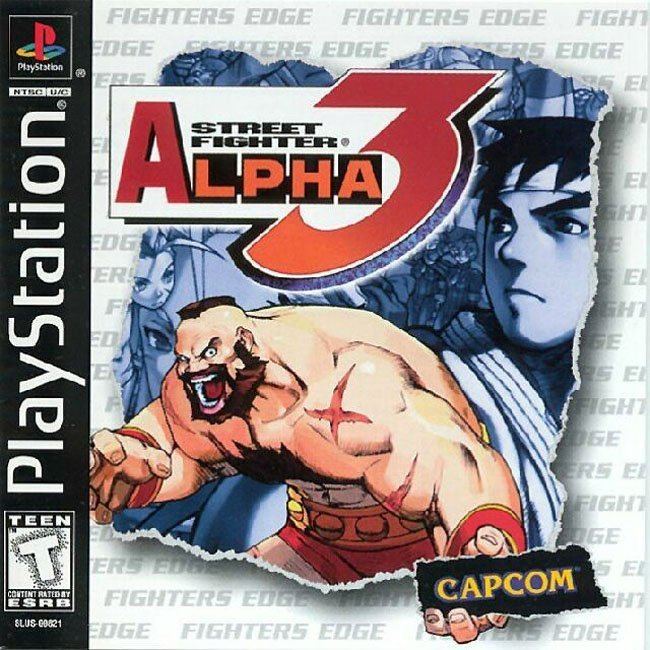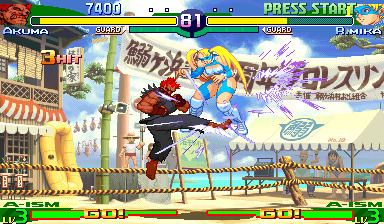8.8 /10 1 Votes
Initial release date 1998 | 4.4/5 Emuparadise Cabinet Upright | |||||||||||||||||||||||||||||||||
 | ||||||||||||||||||||||||||||||||||
Composer(s) Takayuki IwaiYuki IwaiIsao AbeHideki OkugawaTetsuya Shibata Mode(s) Up to 2 players simultaneously Arcade system CPS-2Sega NAOMI (Zero 3 Upper) Display Raster, 384 x 224 pixels (Horizontal),4096 colors on screen,16,777,216 color palette Publishers Capcom, Ubisoft, Sony Interactive Entertainment, CE Europe Ltd., Capcom Entertainment, Inc. Similar Street Fighter games, Capcom games, Fighting games | ||||||||||||||||||||||||||||||||||
Arcade longplay 164 street fighter alpha 3
Street Fighter Alpha 3, known as Street Fighter Zero 3 (ストリートファイターZERO 3) in Japan and Asia, is a 1998 fighting game by Capcom originally released for the CPS II arcade hardware. It is the third game in the Street Fighter Alpha series, following Street Fighter Alpha: Warriors' Dreams in 1995 and Street Fighter Alpha 2 in 1996, although it was released after the Street Fighter III series had already started (between 2nd Impact and 3rd Strike). The gameplay system from the previous Alpha games was given a complete overhaul with the addition of three selectable fighting styles based on Street Fighter Alpha (A-ism; called Z-ism in Japan), Street Fighter Alpha 2 (V-ism), and Super Street Fighter II Turbo (X-ism), new stages, a much larger roster of characters, and new theme music for all the returning characters.
Contents
- Arcade longplay 164 street fighter alpha 3
- Unlocking street fighter alpha 3 arcade secrets
- Gameplay
- Characters
- Versions
- Reception
- References

Unlocking street fighter alpha 3 arcade secrets
Gameplay
Street Fighter Alpha 3 discards the "Manual" and "Auto" modes from the previous Alpha games and instead offers three different playing styles known as "isms" for players to choose from. The standard playing style, A-ism (or Z-ism in Japan), is based on the previous Alpha games, in which the player has a three-level Super Combo gauge with access to several Super Combo moves. X-ism is a simple style based on Super Street Fighter II Turbo, in which the player has a single-level Super Combo gauge and access to a single but powerful Super Combo move. The third style, V-ism (or "variable" style), is a unique style that allows the player to perform custom combos similar to the ones in Street Fighter Alpha 2, but cannot use Super Combos. In X-ism, players cannot air-block nor perform Alpha Counters, and can only use 1 Super Combo move in its powerful Level 3 version. Alpha 3 also introduces a "Guard Power Gauge" which depletes each time the player blocks – if the gauge is completely depleted, then the player will remain vulnerable to an attack. The I-ism style is customizable when selecting which character and super gauge to be used, which is only exclusive to Dreamcast version's Saikyo Dojo Mode, or PSP version's MAX update on World Tour or/and Entry Modes.
The controls for several actions have been modified from the previous Alpha games. For example, the level of a Super Combo move in A-ism is now determined by the strength of the attack button pressed (i.e. Medium Punch or Kick for a Lv. 2 Super Combo), rather than the number of buttons pushed; and throwing is now done by pressing two punch or kick buttons simultaneously.
Characters
The game brings back all eighteen of the characters that appeared in Street Fighter Alpha 2. As with the previous Alpha titles, several characters were added to the game: Cammy, who was previously featured in the console-exclusive Street Fighter Alpha 2 Gold, E. Honda, Blanka, Balrog, and Vega. New characters introduced in Alpha 3 include R. Mika, a Japanese female wrestler who idolizes Zangief; Karin, Sakura's rival who was first introduced in the Street Fighter manga Sakura Ganbaru! by Masahiko Nakahira; Cody from Final Fight, who has since become an escaped convict; and Juli and Juni, two of Shadaloo's "Dolls" who serve as Bison's assassins and guards.
The PlayStation version added the remaining characters introduced in Super Street Fighter II: Dee Jay, Fei Long, and T. Hawk, along with Guile from Street Fighter II, Evil Ryu and Shin Akuma from Street Fighter Alpha 2, the last two being unlockable. The Sega Saturn and Dreamcast versions move Guile and Evil Ryu to the default.
The Game Boy Advance port contains all of the characters from previous versions, as well as three additional characters: Yun from Street Fighter III, Maki from Final Fight 2, and Eagle from the original Street Fighter, all three based on their incarnations from Capcom vs. SNK 2: Mark of the Millennium 2001. The PlayStation Portable version, Street Fighter Alpha 3 MAX, also adds Ingrid from Capcom Fighting Evolution, to bring the total character count to 38 characters.
Versions
Reception
On release, Famitsu magazine scored the Sega Saturn version of the game a 32 out of 40; they later scored it 30 out of 40. The PlayStation version also scored 32 out of 40 on release. The Dreamcast version scored slightly better, receiving a 33 out of 40.
The Official UK PlayStation Magazine said that the game would outlast Tekken 3, and stated "the only thing to tarnish this is the graphics. So if you think gameplay is more important than texture-mapped polygons, consider the score to be a ten."
By 2003, the Game Boy Advance version had sold over 30,000 copies. Meanwhile, the original PlayStation version sold a million units as of June 2016.
